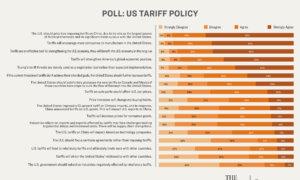Canada and Mexico are two of the largest aluminum and steel trading partners of the United States.
President Donald Trump on Feb. 10 is expected to impose 25 percent tariffs on all steel and aluminum imports.
Speaking to reporters on Air Force One as he flew from Florida to New Orleans on Sunday to attend the Super Bowl, Trump said he would announce a 25 percent levy on “any steel coming into the United States,” adding “aluminum, too.”
The president also said he would announce “reciprocal tariffs” soon. Under this plan, the United States would implement import duties on goods and services when another country slaps tariffs on U.S. products.
“If they are charging us 130 percent and we’re charging them nothing, it’s not going to stay that way,” Trump said. “If they charge us, we charge them.”
Repealing Section 232 would ultimately lead to the creation of more than 4,000 jobs and a long-run GDP growth of 0.02 percent, or $3.5 billion, said Alex Durante, the senior economist at the Tax Foundation.
Canada Responds
In a separate pre-taped interview with Fox News released on Sunday, Trump stated that he had not seen enough action from Canada and Mexico to avoid tariffs after agreeing to a 30-day pause.
“No, it’s not good enough,” Trump told host Bret Baier. “Something has to happen. It’s not sustainable. And I’m changing it.”
Last week, the president agreed to a 30-day extension on his initiative to apply a 25 percent levy on all goods coming from Canada and Mexico. Canadian oil, natural gas, and electricity imports would be taxed at a lower rate of 10 percent.
Senior Canadian officials, including François-Philippe Champagne, minister of innovation, science, and industry, pledged to “stand up for Canada,” its workers, and its industries.
“Quebec exports 2.9 million tons of aluminum to them, or 60 percent of their needs. Do they prefer to get supplies from China?” he wrote.
“We must put an end to this uncertainty.”
Market Reaction
Although Trump’s first threat of 25 percent tariffs on his North American trading partner ignited enormous volatility in the financial markets, U.S. stocks were up in the green to kick off the trading week.
The leading benchmark indexes were up as much as 0.7 percent before the opening bell.
Tom Essaye, president and founder of the Sevens Research Report, believes the U.S. stock market can maintain its gains despite the headwinds.
“Can stocks rally if we keep getting these tariff threats and headlines?” Essaye wrote in a note emailed to The Epoch Times. “The answer, I believe, is ‘yes,’ but it’s going to require nearly universally positive news from the remaining bullish factors in this market.”
The bullish factors are the Federal Reserve continuing to cut interest rates, stable economic growth, enthusiasm for artificial intelligence, and hopes for extending the Tax Cuts and Jobs Act.
“As long as all of them remain a consistent flow of positive headlines, then markets can overcome tariff headlines and volatility to continue to rally,” Essaye said.
Wall Street will have a busy week ahead as investors monitor Federal Reserve Chair Jerome Powell’s two-day appearance on Capitol Hill and digest two key inflation reports.
Original News Source Link – Epoch Times
Running For Office? Conservative Campaign Consulting – Election Day Strategies!


